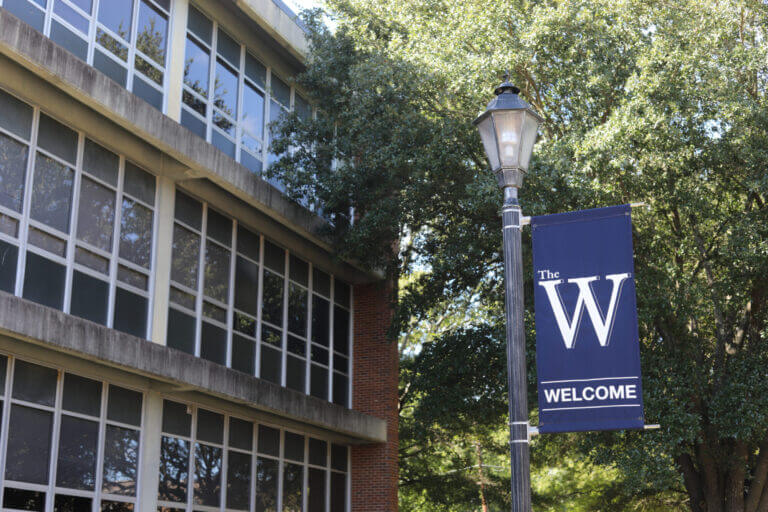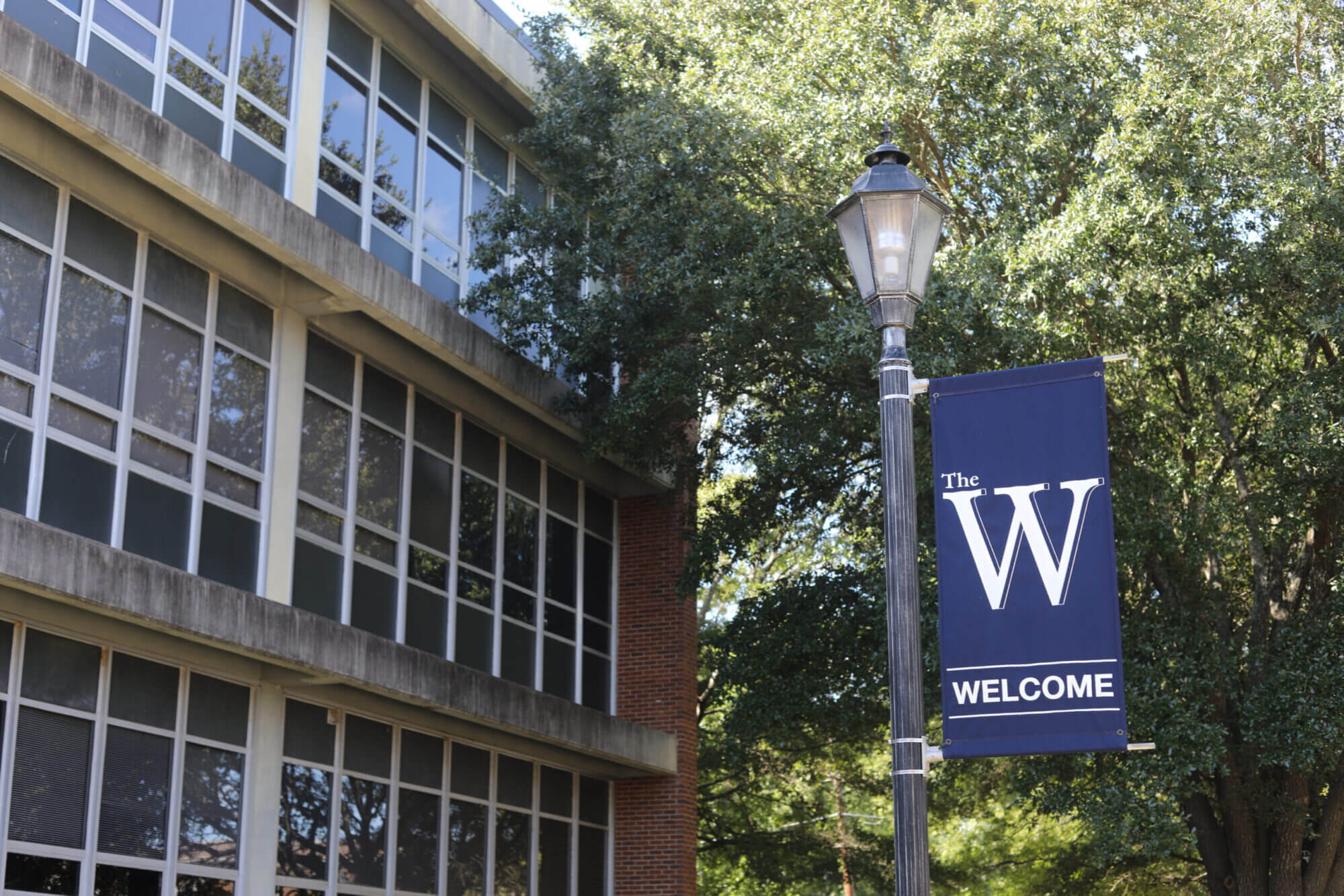

This story was reported in partnership with The Commercial Dispatch.
Mississippi University for Women’s administration went back to the drawing board last year after attempts to rebrand to a genderless name were met with resistance from alumni and inaction in the Legislature.
“Please note that we will always be The W,” the president, Nora Miller, wrote in a statement late last February. “It is our past, our present, and our future.”
But by mid-March 2024, MUW was uncertain it had a future at all.
In a surprising move, a senator from south Mississippi had proposed merging the state’s only liberal arts institution into Mississippi State University, a behemoth land grant in Starkville about 30 miles from MUW. The effort had replaced a bill to transfer the location of the Mississippi School for Math and Science, the state’s only residential school for gifted children, from MUW to MSU.
Amid this messy moment, MSU internally came up with its own name for MUW.
“In fact, the campus could be known as the W – representing Workforce,” the provost, David Shaw, wrote in a white paper named “Vision for Columbus” that he circulated to his administrative colleagues on March 11.
The “vision for Columbus” went further: In the white paper, Shaw conceived of turning MUW into a campus for nursing, speech pathology and culinary arts, plus other technical and workforce programs such as a college focused on professional and continuing studies. Freshman and sophomore courses would stay in Starkville, but some programs could be transferred to Columbus.
Two days later, the merger bill died in the Senate. Its author, Sen. Dennis DeBar, R-Leakesville, and other key lawmakers including Lt. Gov. Delbert Hosemann told Mississippi Today and The Commercial Dispatch that they never saw the white paper.
“I’m not saying it didn’t happen, but I don’t remember anything like that because we talked about a lot of stuff last year regarding The W and MSMS,” DeBar said, referring to the Mississippi School for Mathematics and Science.
Rep. Rob Roberson, a Republican from Starkville who chairs the House Education Committee, was also surprised.
“That’s a new one to me,” he said.
Sen. Chuck Younger, a Republican who represents Lowndes County, said he doesn’t remember being presented with a new plan for the MUW campus.
“If it was, I didn’t read it because I was just fighting against it,” he said.
MSU has never made any public overtures for taking MUW, and its strategic plan does not include acquiring another campus. Last year, President Mark Keenum publicly said his university did not propose or initiate the takeover bill.
“We appreciate the institutional confidence in MSU that this proposal implies, but I emphatically reiterate that MSU did not seek and has not requested this action from legislative leaders,” he said in a statement.
This session, the land grant university appears to have mainly focused on acquiring MSMS after the State Board of Education requested both it and MUW submit proposals to house the residential high school before later approving MSU’s plan. A bill to merge MUW and MSU has not been reintroduced this legislative session.
But questions about the white paper, which sketched out what MSU would need from the Legislature to acquire MUW, remain unanswered. An MSU spokesperson, Sid Salter, said the university had no comment, and Shaw did not return multiple calls and an email requesting comment.
Miller said she was not surprised to learn of the proposal. She said MUW already contributes to the state’s workforce, especially its nursing program, where more than 80% of graduates continue to work in the state.
But she added that the notion of turning the state’s only public liberal arts institution into a campus for workforce development disregards other facets of MUW’s identity, like its music program or the Welty Symposium.
“We are an important provider of workforce in the community and in the state,” Miller said. “While I’m ready to embrace that, I think it just changes the fabric of this institution, of its founding and of what people really associate with us.”
As a part of its plan for Columbus and MUW, Shaw wrote that MSU would “reimagine the campus to make it unique in Mississippi with a distinct identity,” drawing on work it has done to build up its Riley campus in Meridian.
After spending a year listening to local, regional and state leaders, MSU would also bring new programs to MUW’s campus and build on existing partnerships with industry and other institutions, like the Columbus Air Force Base.
“MSU would explore expanded partnership with East Mississippi Community College, effectively creating an 82 corridor, also meeting the needs of the industry at the GTR (Golden Triangle Regional) airport and industrial park,” Shaw wrote.
This was not proposed as an immediate cost-saving measure, however. In the white paper, Shaw noted that in order for it to take over MUW, MSU would need to retain the same level of state appropriations that MUW was already receiving — and receive new funding to transfer MSMS to Starkville.
MSU would also need approval to demolish or transfer ownership of “buildings in disrepair” and “consideration of financial exigency to allow elimination of unnecessary or duplicative positions on the campus of the W.”
Miller said the local community would be saddened to see some of MUW’s buildings go.
“It would break my heart to see some of these historic buildings demolished when I think of the lives that have gone through those buildings, that have lived there, that have meant so much,” she said.
But some in MSU’s administration saw this as an opportunity. Responding to Shaw, Salter wrote in an email on March 12 that “the disposition of buildings is where MSU can win back city and county support and grow community buy-in.”
Salter suggested talking with local leaders about the buildings, adding, “Who needs, wants what?”
Crucially, the white paper also noted that MSU would need funds for the transfer of MSMS to Starkville “to be co-located with the Starkville Oktibbeha School District high school to be constructed on the MSU campus.”
While The W’s enrollment dropped by 1.5% this year to 2,193 students, Miller said lawmakers will find her school excels in other data points.
“If they want to judge us by the affordability for our students, the amount of debt that we’re helping with, with the employability of our graduates, if they want to look at the number of degrees – if they look at all of those, we do very well,” Miller told The Dispatch in November. “If they’re just looking at headcount, yes, we’re smaller than we used to be. Most regional institutions across the country are smaller than they used to be.”
Though the merger bill did not return this session, the future of higher education remains on lawmakers’ minds. The chair of the Senate Colleges and Universities Committee, Nicole Boyd, R-Oxford, used her chamber’s anti-DEI bill to reintroduce a taskforce, which failed to pass last year, to study efficiency in the state’s higher education.
Boyd has repeatedly stated the goal of her taskforce is not to close or merge universities, but she plans to hold committee hearings this fall to examine some of the issues she hoped the taskforce would probe.
Indeed, “efficiency” was important for MSU’s vision for Columbus. Salter wrote on March 12 that administrative functions like public relations, campus police, and dining contracts could be combined, depending on how robust the new “workforce” campus would be.
“Imperative to identify who among the current MUW personnel needs to survive the merger and be visible in the new regime,” he wrote.
The post Internal Mississippi State memo proposed renaming The W for ‘workforce’ appeared first on Mississippi Today.
- IHL taps members for Jackson State president search advisory group - November 24, 2025
- DNA evidence tied to rape, killing of 6-year-old Greenville girl is missing, attorneys allege in court filing - November 24, 2025
- Egg Bowl week begins as Kiffin’s run at Ole Miss appears to be at end - November 24, 2025